 |
| Jim waiting for sunrise |
We got up at 6:30am to watch the sunrise, but it was a bit
disappointing. We should have showered like we intended last night before the
attack of the bugs, because the water was warmer then. By morning, it was like
ice, so we both set new records for how fast we could clean up.
 |
| Nomad's tent, about a 10 minute leisurely walk from camp |
Breakfast was great, and then we set off across the hard pan
for what was billed as a half-hour walk. It was actually less than 10 minutes
to the nearest nomad tent, where we stopped to talk to the widow, who was
carding and spinning dromedary wool on very simple devices. She served tea and
answered many of our questions. The tent they live in is one she wove from the
yarn she spun but on a borrowed loom. They keep both goats and dromedaries, and
she has 8 children, apparently all pretty grownup. They stay in each location
two to four months until the fodder for the herds runs out and they move again.
They have no id cards, and wander freely back and forth across the border to
Algeria, wherever their herds take them. They had homemade goods for sale and
several of us bought colorful scarves and other trinkets.
 |
| Widow spinning camel yarn in her tent |
We took the 4x4s to a school and Hassan started having a
great time "surfing" the sand dunes. Jim in the front seat was in heaven.
I was in the back and definitely not. Hassan is also teaching us the Berber words for things like "thank you" and "ok" whenever we use the Arabic or English. Jim is able to converse with him a bit in French too.
We ended up in a school, where the
teacher had 1
st and 2
nd graders. He had formerly taught
high schoolers and was enjoying his transition to a younger age who still
wanted to learn. They sang the Moroccan national anthem at the top of their
lungs and then showed us their prowess as he called out a number and they wrote
each one down in succession on little individual blackboards. They seemed to
develop a competition for who could be fastest and little girl in the back near
us showed us her answer before showing the teacher. They all did well for only
2 weeks worth of instruction and probably little or no encouragement or
practice at home. Unfortunately, we were not allowed to photograph the class. I
found it interesting that they had three versions of the alphabet: French,
Arabic, and Berber which apparently was taken from the Phoenicians. I had seen
the Berber writing occasionally before without knowing what I was seeing.
 |
| Peeking into the school, seeing the teacher |
We also visited a couple irrigated farms with dates,
alfalfa, and goats. The date farmer was harvesting(not a great year because of
winds from the east pushing sand into the fields) and he demonstrated climbing
a palm tree to whack off the stems with the dates. On our way out, we passed a
sheep and goat enclosure. One of the goats peaked out curiously until a brown
ram raced up and brayed at her to get back inside and mind her own business.
Our next stop was a community well where a woman was carefully washing rugs in
short wide pails and another woman with three small children and a donkey
brought a bunch of plastic bottles to the well to be filled.
 |
| How to pick dates |
 |
| Curious girl goat |
 |
| Unhappy boy goat telling her there is nothing to see |
Our last stop before lunch was hilltop that was loaded with the kind of
fossil-loaded rocks we had seen the day before in finished condition. Jim and I
searched, moving far away from the central staging area trying to find a small
enough rock to cart home that had a nice fossilized image in it. We did come up
with some options, all mostly bigger than we wanted.
After lunch back at camp, it was just too hot to go hiking,
so I am working on the blog and reading and Jim is playing chess on the tablet.
We are looking forward to sundown, and I will certainly take a shower tonight
before bedtime since the one in the morning can only be called short and
unsatisfying.
Unfortunately, the water in the afternoon was only slightly warmer in the morning and not consistent, but at least I felt a bit cleaner and relaxed until dinner. We watched the sunset again and had a campfire afterwards, with the camp staff, drivers, and Driss entertaining us with drums and song. Driss even danced and then encouraged the group to join in, which most did. All that was missing was the s'mores.
 |
| Another Sahara sunset |
Our tactic of closing the shutters before dinner to keep out the light-attracted bugs was very successful and we had a much more pleasant evening after we repaired to out tent for the night than we had the previous evening.






























































